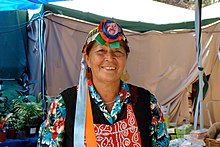You can help expand this article with text translated from the corresponding article in Spanish. (August 2021) Click [show] for important translation instructions.
|
| Languages of Chile | |
|---|---|
 Sign in Puerto Montt in Spanish, English and Mapuche | |
| Official | Spanish (de facto) |
| Indigenous | |
| Regional | |
| Vernacular | Chilean Spanish, Patagónico |
| Signed | |
| Keyboard layout | |

Spanish is the de facto official and administrative language of Chile. It is spoken by 99.3% of the population in the form of Chilean Spanish, as well as Andean Spanish. Spanish in Chile is also referred to as "castellano". Although an officially recognized Hispanic language does not exist at the governmental level, the Constitution itself, as well as all official documents, are written in this language.
Indigenous peoples make up 4.58% of the Chilean population according to the 2002 Census, and the major languages of the population are as follows: Mapuche is spoken by an estimated 100,000–200,000 people; Aymara by 20,000 individuals; Quechua by 8,200 individuals; and Rapa Nui by 3,390 people. However, it is not explicit whether all these speakers use the language as their primary language.
According to Law 19253, also known as "The Indigenous Law" (1993), indigenous languages are officially recognized for use and conservation, in addition to Spanish, in the zones in which they are spoken. They can be used for instruction, the promotion of media communication, as names in the Civil Registry, as well as for artistic and cultural promotion.
Bilingual programs in areas occupied by indigenous communities are also under development. However, these programs exist only as small, isolated projects dedicated to the maintenance and promotion of indigenous languages, specifically Mapuche and Aymara, both with varying degrees of success.
